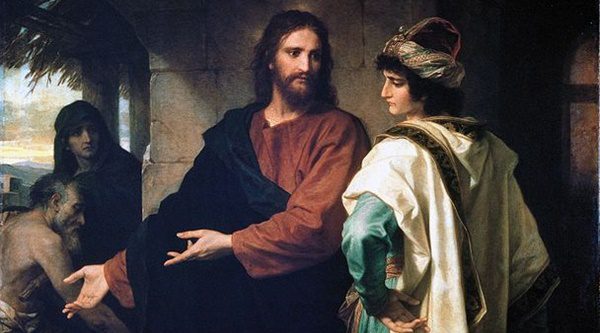
Pastors have a frequent question when they begin to discover mimetic theory. “That’s great. But how does it preach?”
Reverend Tom Truby shows that mimetic theory is a powerful tool that enables pastors to preach the Gospel in a way that is meaningful and refreshing to the modern world. Each Wednesday, Teaching Nonviolent Atonement will highlight his sermons as an example of preaching the Gospel through mimetic theory.
In this sermon, Tom explores how Jesus was glorified. Tom speaks to the heart of mimetic theory’s implications for theology when he writes about the atonement and resurrection, “Jesus loves us by allowing himself to be “glorified” on the cross! He allows himself to die to our violence and then forgives us as we exhibit it. Then God raises Jesus from the dead to show us that Jesus speaks for God.”
Year C, Easter 5
April 24th, 2016
Written by Thomas L. Truby
John 13:31-35 and Revelation 21:1-6
“Glorified!”
“When he had gone out, Jesus said, ‘Now the Son of Man has been glorified, and God has been glorified in him.” Who has just gone out? Whom ever it was, his departure seems decisive. Jesus says his leaving starts the action that leads to “the glorification of the Son of Man.” Do you know who left? Yes, it was Judas, son of Simon Iscariot.
We don’t know what Judas was thinking. Maybe he was disappointed in Jesus because Jesus does not seem willing to take up arms against their enemies. The full name John gives Judas is “Judas, the son of Simon Iscariot.” “Iscariot” means “the assassin.” Do you suppose John included that whole long name because he wanted us to know that Judas was thought of as “The Son of the Assassin?”
Some think Judas hoped to shock Jesus into violent action by forcing a confrontation with Jewish religious and legal leaders and that’s why he went to the authorities. In his own mind he wasn’t betraying the movement so much as enhancing it. He would force Jesus’ hand. When the authorities came to arrest Jesus, surely Jesus would resist and show some of the power that Judas had seen him use so many times in healing people. I’ll bet it never occurred to Judas that Jesus would remain totally non-violent even when faced with losing his freedom and possibly his life.
And why in John’s account does Jesus refer to himself as “the Son of Man?” What does that mean? Interestingly, in this condensed story we have “Judas, the son of Simon, the assassin” and Jesus, the Son of Man.” Judas and Jesus appear to have very different visions for how to accomplish profound cultural change.
How can anyone be “the Son of Man?” Is his father all of humanity? Does he somehow feel connected to the human species? Yes! He does, and the connector is love. In the thing Jesus is about to do he has a message for all humans. In going to the cross he is taking us all with him. We are all there. We all do to him what is about to be done. No one is exempted. He is showing us who we are as we reveal ourselves in what we do to him. In doing this he serves all humanity because we couldn’t see “this thing hidden since the foundation of the world” in any other way.
When Judas left that night to set up the conditions that would lead to Jesus’ death, Judas represents us all. And when the Son of Man did not resist our violence with a display of his own counter-violence, but instead submitted to it, he serves us all even though we don’t understand this very well. He deliberately makes himself less powerful than we are so that the limits of power can be shown and a new resurrected way discovered.
Jesus knows it is not power that runs the world; it’s love. And this is where the glorification comes in. The “Son of Man” is glorified in his willingness to go to the cross to show us the truth about ourselves and the truth about God. There is no other way we would see it and so he has to do it. This is why when Judas left the room to turn Jesus in Jesus said “now the Son of Man has been glorified.” Judas’ action set the gears in motion that led to Jesus’ death and resurrection and it is his death and resurrection that show his glory.
Not only is Jesus glorified, God has been glorified in Jesus. In ancient Greek glorification means “adds to the reputation of.” So Jesus adds to his own reputation as a clear-eyed lover by being willing to die to show us what we do to each other and he adds to God’s reputation as a lover by showing us the length to which God will go to get through to us. This is what the atonement is all about. But the glorification comes not just in terms of the crucifixion, it comes in the resurrection. God’s forgiveness finds expression in his willingness to continue to love us in spite of what we do.
In the crucifixion and resurrection we are given all we need to know. It’s all there—anthropology and theology. This whole thing is an act of communication attempting to break through our delusional thinking and suicidal living. This is God’s glory and Jesus adds to his reputation by showing us what God is like. Jesus shows us what God is like so that we see God as he is and not as a projection of our own violence.
I noticed something I have never noticed before in reading John’s text. Just before Judas left that night, Jesus gave him a piece of bread to eat. In N. T. Wright’s translation it says, “So when Judas had taken the bread, he went out at once. It was night.” Judas had communion! He too was included in the resurrection life. A couple of days later he hung himself but he was still included. Even Judas was included in God’s inclusive love. This act of forgiveness, just before the betrayal, this act so beyond human capability and imagination, shows us the full radiance of God’s glory. God’s profound and wonderful reputation is seen in his forgiveness of Judas. Can you fathom that?
Jesus goes on, “Little children, I am with you only a little longer.” Why does the lectionary use this passage from John now? I suppose it’s because we are coming toward the end of Eastertide and soon Jesus ascends and assumes his place at the right hand of God. Jesus is preparing us for this move.
Jesus tells them, “Where I am going you cannot come.” This is something only Jesus can do. Only the Son of Man can be glorified on the cross and resurrection in a way that works to serve humanity. But there is something we can do and as we do it, we will find Jesus with us. As Jesus leaves he says, “I give you a new commandment, that you love one another. Just as I have loved you, you also should love one another.”
How did Jesus love us? The question circles us back to the beginning of this morning’s story. Jesus loves us by allowing himself to be “glorified” on the cross! He allows himself to die to our violence and then forgives us as we exhibit it. Then God raises Jesus from the dead to show us that Jesus speaks for God. God wants us to see that forgiveness and following Jesus chart the way out of our human mess. This circular movement, infinitely deep, takes us to the core mystery of God. Now we are to love each other in the same way.
As with Jesus so with us, this love for each other involves learning to forgive, learning to suffer, and learning to include. This is the behavior by which everyone will know that we are Jesus’ disciples.
Love for one another involves forgiveness toward a younger brother who steals our inheritance and leaves us saddled with a too-high mortgage. It involves suffering as we viscerally feel the impact an unfit mother has had on the development of a vulnerable child. It involves the inclusion of those we know hate us and would destroy us if they could, even while they believe themselves doing God’s will.
When we love one another as Jesus loved us our experience of the world changes. All things become new and have a color and joy they never had before. We are discovering this! John’s vision in Revelation is coming to pass in our lives. The one who is seated on the throne says to us,
“See, I am making all things new.” Also he said, “Write this, for these words are trustworthy and true.” Amen.











